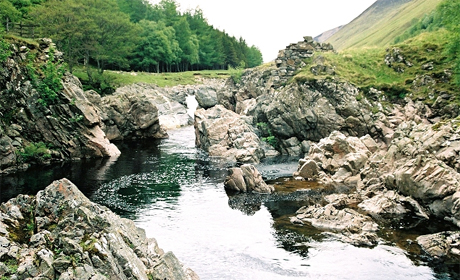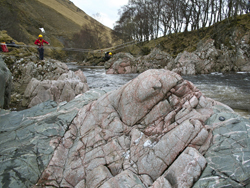Upper end of Glen Tilt
Perthshire, Scotland

One of the earliest geologists to visit Glen Tilt was James Hutton in 1785, whose studies there helped with his concept of deep geological time: ‘no vestige of a beginning, no prospect of an end.’
Glen Tilt is one of the sites where James Hutton found evidence to support his ‘Plutonism’ theory – that heat from within the Earth was responsible for uplifting rocks from beneath the sea onto the land, a theory which opposed Werner’s ‘Neptunism’ theory. In 1785, on a visit to the glen, Hutton discovered many boulders of country rock intruded with granite veins. His theory on observing this was to correctly believe that the granite had once been molten rock that had been forced into the country rock before cooling. He then went on to further prove this theory at other sites, including Salisbury Crags, on the Isle of Arran and in Galloway.
 Here, ‘Older Granites’ from the magmatic phase of the Caledonian Orogeny, are intruded into older Dalradian metasediments. Hutton said of the rocks “the granite is here found breaking and displacing the strata in every conceivable manner, including the fragments of the broken strata, and interjected in every possible direction among the strata which appear”. The rocks he observed lie on the margin of the Glen Tilt Igneous Complex. This complex comprises of predominantly dioritic and granitic intrusions.
Here, ‘Older Granites’ from the magmatic phase of the Caledonian Orogeny, are intruded into older Dalradian metasediments. Hutton said of the rocks “the granite is here found breaking and displacing the strata in every conceivable manner, including the fragments of the broken strata, and interjected in every possible direction among the strata which appear”. The rocks he observed lie on the margin of the Glen Tilt Igneous Complex. This complex comprises of predominantly dioritic and granitic intrusions.
At Dail-an-eas Bridge near Forest Lodge where Hutton made his observations, a ‘brick-red’ coarse grained granite is included by the metasediments of the country rock. Both granite and metasediments are cut by irregular pink granite veins.
Text: ScottishGeology.com